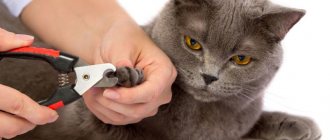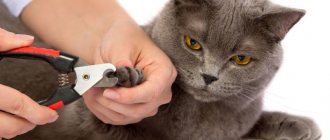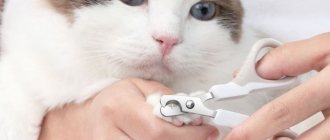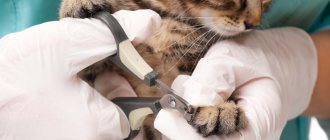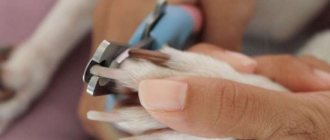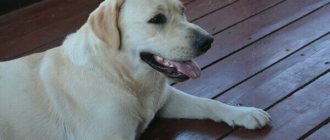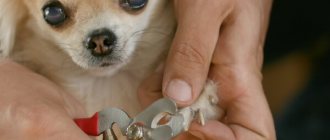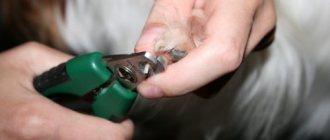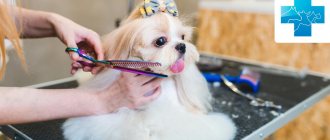Claws are of great importance to cats in the wild. With their help, they climb trees to escape from enemies, hunt and get food for themselves. However, pets living in apartments often cause their owners a lot of trouble. Sharp claws cause damage to furniture, curtains, and wallpaper. Sometimes, while playing, cute fluffies injure the skin of a person’s hands with their claws.
You can get rid of these negative aspects with the help of a nail clipper. This device is popular among pet cat owners. How to choose tweezers? Which tool is the safest? How much does a nail clipper cost? How to trim your pet's nails yourself?
Why does a cat need a manicure?
The cat's hard, sickle-shaped claws, which grow and renew throughout its life, are its formidable weapon, as well as a useful tool that allows it to storm trees and other heights.
In their natural environment, animals have many opportunities to wear down their claws, making them easier to renew. At home, cats have no choice but to be satisfied with a scratching post, wallpaper, door frames, curtains, carpets and, of course, upholstered furniture, which, in their opinion, is simply created for sharp claws to stick into. Tearing soft surfaces is, rather, a pleasant pastime for a cat. It does not provide either grinding of the claws or their shortening, and the animal has to experience discomfort, accidentally clinging with “scratches” to all suitable objects. Sometimes the kitty cannot even free its paw on its own, and then plaintively cries out for help.
It is dangerous to play with a pet armed with long, sharp, curved claws. The first to suffer from them are, of course, children. Don't think that the main threat comes from the cat's front paws. The claws on the hind, pushing, paws, although they grow more slowly, are stronger and tougher. It is with these “daggers” that a pet that has played out can accidentally inflict the most dangerous and deep wound.
In short, regular trimming of cat's claws eliminates or minimizes many problems. This procedure will require patience on the part of the owner, and also a lot of time, because you need to do more than just trim the curved tips of the claws. You will have to follow a certain technique, know at what angle to hold the tool, how to ensure the safety of the “operation”.
Do I need to cut my hair?
Animals' claws grow throughout their lives, and sometimes this causes trouble for their owners. So, playing with a cat, you can get an impressive scratch. Furniture also gets damaged - even adult cats can damage it.
Whether to undertake such a procedure or not is up to the owners to decide. If you are ready to perform such an operation, then keep in mind that small kittens quickly get used to such actions. They are easier to train, and the first haircut can be done already in the second week of life.
It is more difficult with adult cats, especially if such operations have not been performed before. Note that in many cases, removal of excess length is necessary - too large claws cause discomfort to the animal. In addition, indoor cats are less active than their street “brothers”, and they do not have the opportunity to grind off growths on a tree.
Having found out whether it is possible to trim cats’ claws, we move on to a review of the tool.
When and how to accustom a cat to trim its claws
It is advisable to accustom your cat to trimming its claws as a child. Then you can expect that, having matured, she will behave quite humbly during the procedure. But until the kitten is at least a month old, there is no particular point in such science. The baby’s “scratches” are still tiny and small, they are easy to damage, and in the first weeks of life he mainly sleeps and eats. Then you can carry out 2-3 symbolic procedures to prepare the cat for a full “manicure”. It can be done when the pet is 3 months old. By this time, the claws will noticeably harden and become sharp.
It is more difficult to train an adult cat to have its nails trimmed. However, over time she will get used to this manipulation, although she will not behave like a lady in a nail salon offering her hand herself. Regardless of the age of the animal, it will have to be persuaded to trim its claws, forgetting about brutal coercion. If the pet hisses and breaks away from your hands not formally, but demonstrating real anger or extreme fear, the procedure must be postponed.
First of all, you need to choose a time suitable for the “operation”, when the cat is in a complacent, calm state. This is how he usually looks after sleep or after a substantial portion of food. The purr needs to be placed on your lap, caressed, started a conversation and gently grabbed by the paw. Massage it, quietly approaching the pads. Then press down lightly so that the claws come out.
If you yourself do not have experience, take a good look at the claw to understand where the border of the pulp containing the blood vessel and nerve lies. Under no circumstances should you offend her. Trauma to the pulp will cause pain to the cat and may result in bleeding. You can only cut off the curved transparent part of the claw, stepping back from the pulp by 2 mm. Inside the light claw, the pink pulp is clearly visible, but inside the dark claw, the problem area is almost impossible to determine. You have to shorten the claws by touch, cutting them 1 mm 2-3 times.
While stroking the cat's pads with one hand, take the nail clipper with the other. If the cat is interested in the tool, let him sniff it and make sure that it is not an enemy. You can start trimming if the cat favorably tolerates manipulations with its pads, allows you to expose its claws, in a word, expresses trust in you with its appearance.
Preparation for the procedure
Who else but the owner knows the habits and character of his beloved pet, so he can adapt to it. Nervous, aggressive animals react ambiguously to any procedure. It will be good if 2 people cut the cat’s claws. A cat that is struggling should not be forced, otherwise trimming its claws can lead to injuries on both sides. You just need to wait for the animal's favor before attempting to trim the nails again.
Accustoming an animal to procedures usually begins at the age of a kitten. A small pet should not be afraid of having its paws touched. To trim claws, you should prepare the tools and place them on the table. It is recommended to take the cat in your arms, stroke its back, touch each paw so that it calms down. If the pet is unfriendly and wants to run away, there is no need to forcibly restrain it. It is impossible to do the procedure in this condition; it is advisable to wait 2-3 days.
If the cat behaves peacefully and does not resist touching, it is worth praising it and giving it a treat. He will get used to getting food for this and will allow you to touch his paws. You should talk to your pet, at the same time stretch your fingers one by one, and at the same time inspect the claws. A cat that trusts its owner will not interfere with such manipulations.
What you need to shorten your nails
For the procedure of cutting a cat’s claws, you need to prepare a certain arsenal of tools and tools. Everything you need should be at hand so that you don’t have to be distracted by searching for the item you need at the most inopportune moment. The debut “operation” usually involves special troubles. They usually concern the selection of a suitable tool for trimming cat claws.
It is clear that kitchen and office scissors are not suitable for successfully carrying out a delicate procedure. As for the use of nail scissors, this too is questionable. Firstly, they are not very convenient to operate: the blades in such tools are not designed to cut a dense, round claw, which is why they constantly slip off. Secondly, for cats who do not want to freeze during the “operation”, the sharp tips characteristic of most nail scissors can pose a danger. For those who are absolutely confident in their skills, and at the same time their pets are distinguished by humility, it remains to remind them of hygiene. You cannot trim cat’s claws with “human” nail scissors. You should purchase your own tool for the animal.
It is most convenient to use special scissors - nail clippers, which are offered in specialized stores for animals and on the Internet. They are distinguished by a unique design with reinforced blade edges. Using nail clippers, your cat's hard claws can be trimmed quickly and painlessly. It is advisable to purchase a tool with rubber pads on the handles, since the palm often slips off smooth surfaces.
There are various modifications of nail clippers, so you can experiment before finally choosing the most comfortable option for you and your pet.
Nail clippers come in several basic models.
- Nail clippers-scissors. In its shape, the tool resembles ordinary scissors, but the blades are not straight, but curved at the ends. As they round, they form holes in the shape of holes with a sharp edge into which the claw is inserted. When the blades are closed, it is easily removed.
- Guillotine nail clippers. This tool, which is in great demand today, operates on the principle of the infamous invention of Monsieur Guillotin, used for beheadings. The cat's claw is inserted into a special hole, and the excess part, from the owner's point of view, is cut off with a blade. The mechanism operates a lever on a spring.
- Nail clippers. A convenient device with rubberized thick handles resembles a locksmith's tool. The claw is inserted into the gap between its cutting edges with sharp blades and is literally bitten off by them when the handles are squeezed. Most of these models are equipped with a special limiter, which allows you to trim the claw to a certain length.
- Claw grinders. This is a professional tool for groomers that can be used at home if you understand the principle of its operation. The battery-powered device is equipped with a tip covered with emery, that is, it is not intended for trimming claws, but for grinding them down. Many cats do not like such devices, probably believing that their buzzing is suspicious.
In addition to a nail clipper, for a cat “manicure” you will definitely need:
- cotton wool or cotton pads;
- disinfectants (hydrogen peroxide is best);
- hemostatic agents (hemostatic sponge, special powder, dry potassium permanganate).
Owners of especially fluffy cats may need a hair clipper to treat the area around the toes before trimming their nails.
For cat owners who perceive “manicure” as an execution and actively resist it, fixing overalls will help them cope with the task. They can be bought at pet stores.
In the set of accessories for trimming nails, many owners include a file or an emery block designed specifically for animals.
Can scissors and clippers be used on human nails?
Some cat lovers are interested in whether it is possible to trim claws with regular scissors and, conversely, use a cat nail clipper to trim human nails. It is not recommended to do either one or the other.
Before purchasing, you need to carefully examine your pet's paws. If the claws are small and thin, then you should give preference to nippers, and for large claw plates, a guillotine is suitable. It is equally important that the tool is convenient for the person who will use it.
How to properly trim a cat's claws
Before you begin the exciting procedure, you need to make sure that the cat is in a good mood. The state of mind of the owner is also important. He must exude positivity, goodwill and at the same time – inflexibility and self-confidence. Under no circumstances should you fuss.
- Place a light near your work area so that you can carefully examine the claw, determining where the pulp begins.
- Wash your hands with soap, treat them with an antiseptic, and disinfect your chosen nail trimming tool.
- Gently sit the cat on your lap (with its back facing you), take the paw that you will treat first in your hand, and hold it firmly. If the animal begins to actively object, swaddle it in a towel or dress it in overalls. You may need to call an assistant to help.
- Gently press the center of the pad with your fingers to extend the claw to its maximum length.
- Place a nail clipper (scissors) on the curved part of the claw, choosing the correct angle - along the line of its growth, that is, the trimmed claw should not differ in shape from the untrimmed one. The cutting direction is from bottom to top.
- Stepping back at least 2 mm from the edge of the pulp, cut off part of the claw in one motion.
- If there are any rough spots left on the claw, you can get rid of them using a nail file, a diamond-cut file, or a whetstone. Just keep in mind that friction usually causes extreme irritation and anxiety in the animal. In addition, there is a risk of delamination of the claw if its edges are processed with excessive force. The pressure should be light.
- Trim all the claws, then give the cat a treat, even if she has not shown submissiveness.
Don't forget that the fluffy has 18 toes with claws (5 on the front paws and 4 on the back paws). At the end of the procedure, it is advisable to make sure that you have processed each one. One forgotten sharp claw can create discomfort for an animal.
Possible dangers
Troubles during the nail trimming procedure usually await rebellious cats that squirm on the owner’s lap. In this case, both participants in the process can be injured by the cutting or grinding tool. A tragedy will probably not happen, and light bleeding wounds can be healed with the help of antiseptic and hemostatic agents. The danger zone is the animal's eyes. When a cat begins to show excessive fidgetiness, the tool, especially if it is pointed nail scissors, should be put aside for a while.
Traditionally, the main threat to the animal is the carelessness or inexperience of the owner, and it is associated with injury to the pulp. If you overdo it, hitting the vessels with a claw clipper, blood will inevitably appear. There is no need to panic when you see her. It is necessary to disinfect the injured claw with hydrogen peroxide, and then treat the wound with a hemostatic sponge or hemostatic powder. If you use dry potassium permanganate, make sure that it only covers the damaged area. Contact of this drug on the skin may cause burns.
Typically, bleeding can be stopped within 5 minutes. If for some reason the bleeding cannot be controlled, you will have to take the injured pet to the veterinarian. You will also need to visit a specialist if you discover that the fifth claw on one of the front paws has begun to grow into the pad. This is a fairly common occurrence. The claw, located slightly to the side of the other four fingers, does not experience any impact at home and does not even touch the floor, so it grows the fastest.
How often to trim your cat's claws
The frequency of the procedure depends on how quickly your cat's scratches grow. This is an individual indicator, but in all fluffies, the claws on the front paws grow faster than on the hind paws. Whether it's time to shorten them can be easily determined visually. The pet’s behavior will also indicate that it’s time to trim its claws: the cat will begin to sharpen its “scratches” more often and cling to everything with them.
Some pets get a manicure once every 2 weeks, others once a month. It is also worth considering that a cat accustomed to a scratching post may not need to have its claws trimmed very often. There is also no need to be zealous if the cat is preparing to move to a country house for the summer, where a free man awaits him. A released animal cannot do without a formidable weapon!
